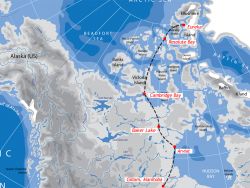Art Mortvedt: Real Raconteur…
Published on 04.05.2011 - Polar Flight 90
Thanks to pilot Art Mortvedt, we get to see a little of that remote part of the world, the Nunavut Territories.
We would have let Art Mortvedt quietly return home with his Cessna without writing any more updates on arrival (all in all not inevitably interesting) if the latter had not been such a superb raconteur.
First of all, he doesn’t seem to want to go straight back to his place of abode, Alaska. And he has decided to head further south towards the western shores of Hudson Bay. Then, each evening at the stopover, he involves his visitors in an enthralling account of the happenings of the last twenty-four hours. As the flight in itself is of course of less importance than when he was heading for the North Pole, he focuses more on the regions over which he flies and names the various people whom he meets.
As the geographical areas that he frequents on his journey home are places extremely little frequented and therefore virtually unknown, what Art tells us - provided that discovery is a pet subject - is quite simply not only pleasant to read but is also extremely interesting educationally.
Here therefore are some extracts from his logbook:
29 April : "... As a high school student in the small town of Stanton, North Dakota, I had read Farley Mowat's first book - "People of the Deer" - about his 1947-1948 study of the Ilhalmuit that supposedly traditionally lived in the "Barrenlands", over which I was now flying. The land is low rolling rocky topography, interspersed with hundreds of lakes. Judging by the large drifts of snow - everywhere - and nearly no flat spots on which to land a ski plane - it is a land of very high winds. How these "People of the Deer" could survive in such a land was absolutely amazing. Many didn't. Starvation was real. Remy Laserich called this land a "no man's land".
" While flying the last 100 miles to Baker Lake, the weather improved; although there were occasional low clouds. On two occasions, I thought that I had found "springs" of water coming from the ground. One of these was near Garry Lake, a site of traditional Inuit encampments many years ago. Later, in Baker Lake, I was informed that what I actually had seen were sections of rapids in the river, where the water was kept open at all temperatures, due to its cascading velocity. ...
30 April : " ... One of the more exciting events of the day was the "re-intersection" of the treeline - just north of Seal River as it enters Hudson Bay from the west. I had not seen a tree for the past few weeks, as I traveled in the very high Canadian Arctic. The closer I got to Churchill, the more trees I saw. I love trees.
" Churchill is at the mouth of the Churchill River ; and provides a seaport for the import of varied goods from around the world - connecting with the Canadian Railroad, for shipment to the interior of Canada; and also for the export of Canadian grain to customers around the world. Although I knew I would not have an opportunity to see polar bears in the Churchill vicinity, I landed anyway - to stretch my legs and have a cup of coffee..."











